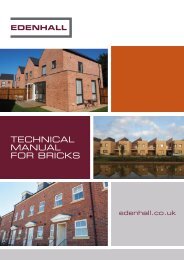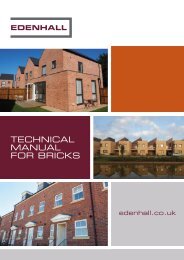You also want an ePaper? Increase the reach of your titles
YUMPU automatically turns print PDFs into web optimized ePapers that Google loves.
Lime based mortars are more flexible and accommodate movement better than pure sand:cement mixes. In addition they have the<br />
capacity for autogenous healing whereby any micro cracks self seal themselves over a period of time.<br />
Experience from sites has shown therefore that if properties are built with no facility for accommodating movement in the form of<br />
joints or bed joint reinforcement in the appropriate locations and strong mortars are used then there is a risk of cracking around the<br />
openings.<br />
12. Do I have to use any special techniques or make any allowances when building with <strong>Edenhall</strong> bricks?<br />
Building with concrete bricks should pose no more problems than using any other masonry products. If anything the dimensions and<br />
consistency of a concrete brick can help with the laying out and maintenance of brick courses.<br />
The product should be dealt with in the same way as if building with dense concrete blocks or reconstructed split walling stone.<br />
The number of courses achievable per day should be between 15-20. Bricks should be kept dry and in accordance with BS 8000-3.<br />
The height of lifts should not exceed 1.5 metres or 20 courses each day.<br />
13. How should movement be accommodated within the structure?<br />
As with all other building materials Concrete Bricks can and will move when subjected to thermal, moisture or structural effects.<br />
In practical terms the shape and height:length ratio of the masonry panels is the major factor in accommodating movement. From<br />
experience we find that vertical movement control measures in the range of 7.5 – 9m in length will be adequate. Ref. <strong>Edenhall</strong> BTB<br />
5: Movement Control.<br />
14. I know that I may have to install vertical movement joints into my elevations but do I also need to incorporate<br />
horizontal joints?<br />
The degree of horizontal movement can be classed as the same as vertical movement, although due to panels being more heavily<br />
loaded “horizontally” the requirement is likely to be less than for vertical movement control which <strong>Edenhall</strong> recommends at 7.5 – 9m.<br />
Generally speaking horizontal joints are not required on two storey buildings, but in buildings that exceed 4 storeys or 12 metres in<br />
height they should be installed at every second storey. Particular attention should be given to low level parapet walls at the top of<br />
a building which may be relatively lightly loaded and are long and slender. Should “horizontal support” be under consideration then<br />
<strong>Edenhall</strong> would suggest reference to a suitably qualified engineer or specialist fixing company. Ref. <strong>Edenhall</strong> BTB 5: Movement<br />
Control.<br />
15. How cost effective is bed joint reinforcement and is it really necessary?<br />
Bed joint reinforcement (BJR) can be used to control movement and supplement any movement joints. It is not intended to fully<br />
replace movement joints but the manufacturers claim that it allows joint spacing to be increased by up to 50%. It should be of the<br />
lattice or ladder type which consists of two parallel flat stainless steel bars cross-linked at intervals by wires. In essence it looks<br />
like a model railway track. The wire is generally oval in shape, compressed down to 3mm, and 60 mm wide. It is inserted into the<br />
mortar bed and is therefore hidden. It should not be confused with lightweight mesh which is sometimes used to bond internal walls<br />
together.<br />
The purpose of BJR is to increase the tensile strength of a wall and dissipate any internal stresses over a wider area, thus reducing<br />
the risk of cracking. It is mainly used above and below openings and should extend some 600mm either side of the opening.<br />
Generally speaking we recommend it for openings greater than 1.5 metres. Normally two courses are installed at the first and third<br />
course above the opening. The use of BJR is not restricted to concrete bricks or blocks - the Brick Development Association also<br />
recommends its use with clay bricks.<br />
The cost of BJR varies between £1.20 and £1.50 per linear metre depending on manufacturer. This equates for example to under<br />
£10 to install it above a large patio door. It is particularly effective in examples such as front elevations where installation of a<br />
movement joint would be neither practical nor visually attractive. The cost overall for a full house can be set off against the savings in<br />
forming movement joints and the cost of remedying or replacing any cracked bricks and should be viewed within the context of the<br />
whole build cost.<br />
16. What key characteristics change dependent on the form (solid, frogged, perforated) of <strong>Edenhall</strong> bricks?<br />
The main differences that the form makes relate to weight and density of the brick and brickwork. Ref. <strong>Edenhall</strong> BTDS 1: Facing<br />
Bricks and BTDS 4: Dense Common Bricks.<br />
17. Can I use <strong>Edenhall</strong>’s Frogged or Perforated bricks as coursing units?<br />
Coursing bricks are normally used in conjunction with blocks to make up course heights; fill gaps within blockwork and for use in<br />
reveals. They may be subject to being cut or drilled and although in theory the bed face mortar will make a frogged or perforated<br />
brick “solid”, this mortar typically has an average strength which is less than the blocks or bricks. NHBC requires that infill units<br />
have to be compatible with the background block so therefore a solid brick is ideally suited to a solid block of similar performance<br />
characteristics. Ref. <strong>Edenhall</strong> BTB 10: Coursing Brick Applications.







